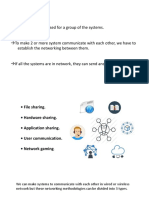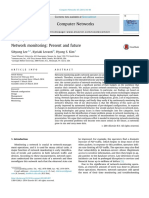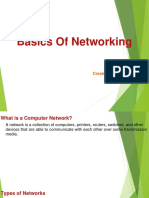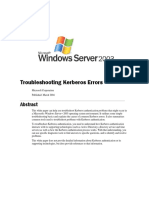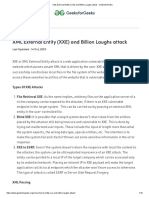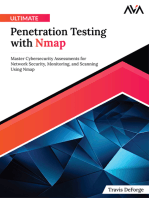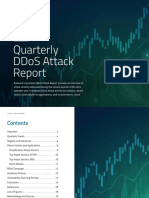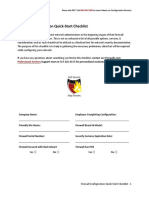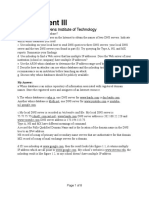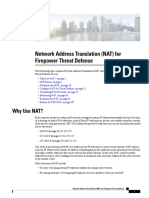DNS Advanced Attacks and Analysis
DNS Advanced Attacks and Analysis
Uploaded by
AI Coordinator - CSC JournalsCopyright:
Available Formats
DNS Advanced Attacks and Analysis
DNS Advanced Attacks and Analysis
Uploaded by
AI Coordinator - CSC JournalsCopyright
Available Formats
Share this document
Did you find this document useful?
Is this content inappropriate?
Copyright:
Available Formats
DNS Advanced Attacks and Analysis
DNS Advanced Attacks and Analysis
Uploaded by
AI Coordinator - CSC JournalsCopyright:
Available Formats
Adam Ali.
Zare Hudaib & Esra'a Ali Zare Hudaib
DNS Advanced Attacks and Analysis
Adam Ali.Zare Hudaib
Licensed Penetration Tester
Certified Ethical Hacker
Network Security Defence
Research &Troubleshooting
CEH , ECSA , LPT , WCNA
adamhudaib@gmail.com
Poland
Esra'a Ali Zare Hudaib
israa_hudieb@eng.hu.edu.jo
Computer & Engineering Department
The Hashemite University
Amman . Jordan
Abstract
Nowadays DNS is used to load balance, failover, and geographically redirect connections. DNS
has become so pervasive it is hard to identify a modern TCP/IP connection that does not use
DNS in some way. Unfortunately, due to the reliability built into the fundamental RFC-based
design of DNS, most IT professionals don't spend much time worrying about it. If DNS is
maliciously attacked altering the addresses it gives out or taken offline the damage will be
enormous. Whether conducted for political motives, financial gain, or just the notoriety of the
attacker, the damage from a DNS attack can be devastating for the target.
In this research we will review different DNS advanced attacks and analyze them. We will survey
some of the most DNS vulnerabilities and ways of DNS attacks protection.
Keywords: DNS, DoS, Cache Poisoning, DNSSEC, DNS Hijacking.
1. INTRODUCTION
Denial of Service (DoS) attacks can be classified into two major categories. In the first one, the
adversary featly crafts packets trying to exploit vulnerabilities in the implemented software(service
or protocol) at the target side. This class of attacks includes outbreaks like the ping of death[1].
In the second one, the aggressor attempts to overwhelm critical systems resources, i.e. memory,
CPU, network bandwidth by creating numerous of well-formed but bogus requests. This type of
attack is also well known as flooding. DoS attacks are a threat to almost every service in the
Internet and DNS is no exception. These attacks against or related to DNS servers are also
classified into two types. One is to directly flood DNS servers by sending a large number of DNS
requests or other useless traffic.
Since the DNS servers cannot easily distinguish the legitimate requests from the attack traffic,
they would simply accept both of them and send the responses [2]. The effective and deployable
defense against this attack is to over-provision the network capacity and numbers of servers
[3].The other attack strategy is to exploit DNS servers to amplify attack traffic. The attacker
craftsa DNS request that gets a response significantly larger than the request itself, e.g., a 50byterequest for a 500-byte response. The amplified response is replied to a spoofed third-party
victim machine. Under this attack, both the amplifying DNS servers upstream bandwidth and
the third-party machines downstream bandwidth could be exhausted. Due to traffic amplification,
an attacker can exhaust the bandwidth of its victims even if his bandwidth is 10 times smaller
[4].An effective defense against spoofing-based DoS attacks on DNS servers requires source
International Journal of Computer Science and Security (IJCSS), Volume (8) : Issue (2) : 2014
63
Adam Ali.Zare Hudaib & Esra'a Ali Zare Hudaib
address spoof detection. Assuming a DNS server can distinguish between spoofed requests from
real ones, it can selectively drop those spoofed ones with little collateral damage.
In this paper, we analyze different types of the DNS amplification attacks and ways of protection.
2. DNS ADVANCED ATTACKS AND ANALYSIS
2.1 DNS and The Most Common Security Issues
The Domain Name System (DNS) is a hierarchical, distributed database that contains mappings
between names and other information, such as IP addresses.
DNS allows users to locate resources on the network by converting friendly, human-readable
names like www.microsoft.com to IP addresses that computers can connect to. An often-used
analogy to explain the Domain Name System is that it serves as the "phone book" for the Internet
by translating human-friendly computer hostnames into IP addresses. For example,
www.xyz.com translates to the addresses 20.52.88.12 (IPv4).
By default DNS works on port number 53 on TCP (Transmission Control Protocol) and UDP (user
Datagram Protocol).
DNS is a crucial part of a network and hence securing DNS essentially become quite important. If
a DNS is compromised, an attacker can easily prevent normal operations going in the network,
can route computers to whatever spoofed IP address or resources he wants, steal information
which and a lot of such malicious activity [6].
There are the essential functions of a DNS:
1.
2.
3.
DNS is responsible for locating services like DC, etc. for authenticating the services on the
network There are the essential functions of a DNS:
It is responsible for locating resources like Web Servers, Mail servers, etc. on the network.
And obviously, translating Computer names to IP and vice versa.
There are several most common security issues for DNS.
1.
Unauthorized Authoritative DNS Record Changes Changes to authoritative DNS records
which point end users to computer systems outside of your control can have the most
damage to your business's brand. This type of attack is typically done to either send users
to a site which provides a negative marketing message, or to a location mirroring your site
where account credentials can be harvested. This attack is particularly devastating
because users are typically unaware anything untoward has happened [7].
2.
Denial of Service Attacks Denial of Service (DoS) or Distributed Denial of Service Attacks
(DDoS) are done to make your DNS service unavailable and thus create the impression
your business is offline or closed down (website, portals, VPNs, FTP, VoIP, email, etc.).
This type of attack is one of the easiest to perform and can be one of the hardest to defend
against. One of the least recognized impacts to a business that suffers a DNS outage from
a DDoS attack is the negative effect it has on your search engine rankings.
3.
Recursive DNS Spoofing/Cache Poisoning Outside of a business's control, the Recursive
DNS server an end user utilizes is typically set by the user's network administrator.
Recursive DNS servers communicate the Authoritative DNS records a business sets to an
end user's device. Unfortunately, many Recursive DNS servers are not well maintained or
protected and can be easily compromised to give out false responses. This has the same
down stream effect of an Unauthorized Authoritative DNS record change [8].
International Journal of Computer Science and Security (IJCSS), Volume (8) : Issue (2) : 2014
64
Adam Ali.Zare Hudaib & Esra'a Ali Zare Hudaib
The main vulnerabilities:
1.
Denial of Service.
a. Harm and block DNS traffic.
DNS is an effective DOS attack vector for a few reasons: DNS usually uses the UDP as its
transport; most of autonomous systems allow source-spoofed packets to enter their
network; there is a lot of Open DNS Resolvers on the Internet.
The attack overloads the system by using: DNS reflectors, amplification, botnet; DDOS,
recursive malformed requests, impersonation
2.
Data Modification.
a. Query/Request Redirection.
b. DNS cache poisoning.
c. DNS ID hacking.
Query/Request redirection uses man-in-the-middle position, breaks of the chain of trust.
DNS spoofing forges a fake answer. DNS ID hacking succeeds in impersonating a DNS
server. DNS cache poisoning sends user to malicious site.
3.
Zone Enumeration.
Not really considered as an attack. Most considered as a threat as it allows attackers to
gather information Precedes an attempt at an attack.
4.
Tunnels.
Uses DNS TCP transport mechanism. DNS TCP is used for: failover transport: switch from
UDP to TCP; secondary zone transfer; DNSSEC and IPv6 traffic; EDNS is often badly
supported by customer network.
Attacks use TCP channel to tunnel other protocol and run malicious software [9].
2.2 Types of DNS Attacks and How To Deal with Them
DNS servers work by translating IP addresses into domain names. When DNS is compromised,
several things can happen. However, compromised DNS servers are often used by attackers one
of two ways. The first thing an attacker can do is redirect all incoming traffic to a server of their
choosing. This enables them to launch additional attacks, or collect traffic logs that contain
sensitive information.
The second thing an attacker can do is capture all in-bound email. More importantly, this second
option also allows the attacker to send email on their behalf, using the victim organization's
domain and cashing-in on their positive reputation. Making things worse, attackers could also opt
for a third option, which is doing both of those things.
There are three common types of DNS attacks.
The first type of DNS attack is called a cache poisoning attack. This can happen after an attacker
is successful in injecting malicious DNS data into the recursive DNS servers that are operated by
many ISPs. These types of DNS servers are the closest to users from a network topology
perspective, von Wallenstein wrote, so the damage is localized to specific users connecting to
those servers.
If DNSSEC is impractical or impossible, another workaround is to restrict recursion on the name
servers that need to be protected. Recursion identifies whether a server will only hand out
information it has stored in cache, or if it is willing to go out on the Internet and talk to other
servers to find the best answer.
International Journal of Computer Science and Security (IJCSS), Volume (8) : Issue (2) : 2014
65
Adam Ali.Zare Hudaib & Esra'a Ali Zare Hudaib
"Many cache poisoning attacks leverage the recursive feature in order to poison the system. So
by limiting recursion to only your internal systems, you limit your exposure. While this setting will
not resolve all possible cache poisoning attack vectors, it will help you mitigate a good portion of
them," Chris Brenton, Dyn Inc.'s Director of Security [10].
The second type of DNS attack happens when attackers take over one or more authoritative DNS
servers for a domain. In 2009, Twitter suffered a separate attack by the Iranian Cyber Army. The
group altered DNS records and redirected traffic to propaganda hosted on servers they
controlled. The ability to alter DNS settings came after the Iranian Cyber Army compromised a
Twitter staffer's email account, and then used that account to authorize DNS changes. During
that incident Dyn Inc. was the registrar contacted in order to process the change request.
Defense against these types of attacks often include strong passwords, and IP-based ACLs
(acceptable client lists). Further, a solid training program that deals with social engineering will
also be effective. Unfortunately, all the time and resources in the world can be placed into
securing a webserver, but if an attacker can attack the authoritative server and point the DNS
records at a different IP address, to the rest of the world its still going to look like you've been
owned. In fact it's worse because that one attack will also permit them to redirect your email or
any other service you are offering. So hosting your authoritative server with a trusted authority is
the simplest way to resolve this problem.
The third type of DNS attack is also the most problematic to undo. It happens when an attacker
compromised the registration of the domain itself, and then uses that access to alter the DNS
servers assigned to it.
"At this time, those authoritative nameservers answered all queries for the affected domains.
What makes this attack so dangerous is whats called the TTL (time to live). Changes of this
nature are globally cached on recursive DNS servers for typically 86,400 seconds, or a full day.
Unless operators are able to purge caches, it can take an entire day (sometimes longer) for the
effects to be reversed," von Wallenstein wrote. The main advice for authoritative DNS is to host
authoritative servers within the organization, allowing for complete control [11].
2.3 Amplification Attacks
The amplification attacks are some of the largest, as measured by the number of Gigabits per
second (Gbps). That size of an attack is enough to cripple even a large web host. Even from a
cost perspective, the attack doesn't end up adding to our bandwidth bill because of the way in
which we're charged for wholesale bandwidth.
DNS Amplification Attacks are a way for an attacker to magnify the amount of bandwidth they can
target at a potential victim. Imagine you are an attacker and you control a botnet capable of
sending out 100Mbps of traffic. While that may be sufficient to knock some sites offline, it is a
relatively trivial amount of traffic in the world of DDoS. In order to increase your attack's volume,
you could try and add more compromised machines to your botnet. That is becoming increasingly
difficult. Alternatively, you could find a way to amplify your 100Mbps into something much bigger
[12].
The original amplification attack was known as a SMURF attack. A SMURF attack involves an
attacker sending ICMP requests (i.e., ping requests) to the network's broadcast address (i.e.,
X.X.X.255) of a router configured to relay ICMP to all devices behind the router. The attacker
spoofs the source of the ICMP request to be the IP address of the intended victim. Since ICMP
does not include a handshake, the destination has no way of verifying if the source IP is
legitimate. The router receives the request and passes it on to all the devices that sit behind it. All
those devices then respond back to the ping. The attacker is able to amplify the attack by a
multiple of how ever many devices are behind the router (i.e., if you have 5 devices behind the
router then the attacker is able to amplify the attack 5x, see the figure 1below).
International Journal of Computer Science and Security (IJCSS), Volume (8) : Issue (2) : 2014
66
Adam Ali.Zare Hudaib & Esra'a Ali Zare Hudaib
FIGURE 1: SMURF Attack.
SMURF attacks are largely a thing of the past. For the most part, network operators have
configured their routers to not relay ICMP requests sent to a network's broadcast address.
However, even as that amplification attack vector has closed, others remain wide open [13].
There are two criteria for a good amplification attack vector: 1) query can be set with a spoofed
source address (e.g., via a protocol like ICMP or UDP that does not require a handshake); and 2)
the response to the query is significantly larger than the query itself. DNS is a core, ubiquitous
Internet platform that meets these criteria and therefore has become the largest source of
amplification attacks.
DNS queries are typically transmitted over UDP, meaning that, like ICMP queries used in a
SMURF attack, they are fire and forget. As a result, their source attribute can be spoofed and the
receiver has no way of determining its veracity before responding. DNS also is capable of
generating a much larger response than query.
The key term that I used a couple times so far is "open DNS resolver." The best practice, if you're
running a recursive DNS resolver is to ensure that it only responds to queries from authorized
clients. In other words, if you're running a recursive DNS server for your company and your
company's IP space is 5.5.5.0/24 (i.e., 5.5.5.0 - 5.5.5.255) then it should only respond to queries
from that range. If a query arrives from 9.9.9.9 then it should not respond.
The problem is, many people running DNS resolvers leave them open and willing to respond to
any IP address that queries them. This is a known problem that is at least 10 years old. What has
happened recently is a number of distinct botnets appear to have enumerated the Internet's IP
space in order to discover open resolvers. Once discovered, they can be used to launch
significant DNS Amplification Attacks.
Nowadays there's been an increase in big DDoS attacks. It's in large part because the network
operators listed above have continued to allow open resolvers to run on their networks and the
attackers have begun abusing them.
2.4 DNS Hijacking
DNS hijacking or DNS redirection is the practice of subverting the resolution of Domain Name
System (DNS) queries. This can be achieved by malware that overrides a computer's TCP/IP
International Journal of Computer Science and Security (IJCSS), Volume (8) : Issue (2) : 2014
67
Adam Ali.Zare Hudaib & Esra'a Ali Zare Hudaib
configuration to point at a rogue DNS server under the control of an attacker, or through
modifying the behavior of a trusted DNS server so that it does not comply with internet standards.
These modifications may be made for malicious purposes such as phishing, or for self-serving
purposes by Internet service providers (ISPs) to direct users' web traffic to the ISP's own web
servers where advertisements can be served, statistics collected, or other purposes of the ISP;
and by DNS service providers to block access to selected domains as a form of censorship [14].
A number of consumer ISPs such as Cablevision's Optimum Online, Comcast, Time Warner, Cox
Communications, RCN, Rogers, Charter Communications, Verizon, Virgin Media, Frontier
Communications, Bell Sympatico, UPC, T-Online, Optus, Mediacom, ONO, TalkTalk and Bigpond
(Telstra) use DNS hijacking for their own purposes, such as displaying advertisements or
collecting statistics. This practice violates the RFC standard for DNS (NXDOMAIN) responses
and can potentially open users to cross-site scripting attacks.
The concern with DNS hijacking involves this hijacking of the NXDOMAIN response. Internet and
intranet applications rely on the NXDOMAIN response to describe the condition where the DNS
has no entry for the specified host. If one were to query the invalid domain name
(fakeexample.com), one should get an NXDOMAIN response - informing the application that the
name is invalid and taking the appropriate action (for example, displaying an error or not
attempting to connect to the server). However, if the domain name is queried on one of these
non-compliant ISPs, one would always receive a fake IP address belonging to the ISP. In a web
browser, this behavior can be annoying or offensive as connections to this IP address display the
ISP redirect page of the provider, sometimes with advertising, instead of a proper error message.
However, other applications that rely on the NXDOMAIN error will instead attempt to initiate
connections to this spoofed IP address, potentially exposing sensitive information.
Examples of functionality that breaks when an ISP hijacks DNS:
Roaming laptops that are members of a Windows Server domain will falsely be led to
believe that they are back on a corporate network because resources such as domain
controllers, email servers and other infrastructure will appear to be available. Applications
will therefore attempt to initiate connections to these corporate servers, but fail, resulting in
degraded performance, unnecessary traffic on the internet connection and timeouts.
Many small office and home networks do not have their own DNS server, relying instead
on broadcast name resolution. Many versions of Microsoft Windows default to prioritizing
DNS name resolution above NetBIOS name resolution broadcasts; therefore, when an ISP
DNS server returns a (technically valid) IP address for the name of the desired computer
on the LAN, the connecting computer uses this incorrect IP address and inevitably fails to
connect to the desired computer on the LAN. Workarounds include using the correct IP
address instead of the computer name, or the DhcpNodeType registry value to change
name resolution service ordering.
Browsers such as Firefox no longer have their 'Browse By Name' functionality (Where
keywords typed in the address bar take you to the closest matching site.).
The local DNS client built into modern operating systems will cache results of DNS
searches for performance reasons. If a client switches between a home network and a
VPN, false entries may remain cached, thereby creating a service outage on the VPN
connection.DNSBL anti-spam solutions rely on DNS; false DNS results therefore interfere
with their operation [15].
Confidential user data might be leaked by applications that are tricked by the ISP into
believing that the servers they wish to connect to are available.
International Journal of Computer Science and Security (IJCSS), Volume (8) : Issue (2) : 2014
68
Adam Ali.Zare Hudaib & Esra'a Ali Zare Hudaib
User choice over which search engine to consult in the event of a URL being mistyped in a
browser is removed as the ISP determines what search results are displayed to the user;
functionality of applications like the Google Toolbar do not work correctly.
Computers configured to use a split tunnel with a VPN connection will stop working
because intranet names that should not be resolved outside the tunnel over the public
Internet will start resolving to fictitious addresses, instead of resolving correctly over the
VPN tunnel on a private DNS server when an NXDOMAIN response is received from the
Internet. For example, a mail client attempting to resolve the DNS A record for an internal
mail server may receive a false DNS response that directed it to a paid-results web server,
with messages queued for delivery for days while retransmission was attempted in vain.
It breaks Web Proxy Autodiscovery Protocol (WPAD) by leading web browsers to believe
incorrectly that the ISP has a proxy server configured.
It breaks monitoring software. For example, if we periodically contact a server to determine
its health, a monitor will never see a failure unless the monitor tries to verify the server's
cryptographic key.
In some cases, the ISPs provide subscriber-configurable settings to disable hijacking of
NXDOMAIN responses. Correctly implemented, such a setting reverts DNS to standard behavior.
Other ISPs, however, instead use a web browser cookie to store the preference. In this case, the
underlying behavior is not resolved: DNS queries continue to be redirected, while the ISP redirect
page is replaced with a counterfeit dns error page. Applications other than web-browsers cannot
be opted out of the scheme using cookies as the opt-out targets only the HTTP protocol, when
the scheme is actually implemented in the protocol-neutral DNS system.
2.5 DoS Attacks
Perpetrators of DoS attacks typically target sites or services hosted on high-profile web servers
such as banks, credit card payment gateways, and even root nameservers. This technique has
now seen extensive use in certain games, used by server owners, or disgruntled competitors on
games, such as server owners' popular Minecraft servers. Increasingly, DoS attacks have also
been used as a form of resistance. Richard Stallman has stated that DoS is a form of 'Internet
Street Protests. The term is generally used relating to computer networks, but is not limited to
this field; for example, it is also used in reference to CPU resource management [16].
One common method of attack involves saturating the target machine with external
communications requests, so much so that it cannot respond to legitimate traffic, or responds so
slowly as to be rendered essentially unavailable. Such attacks usually lead to a server overload.
In general terms, DoS attacks are implemented by either forcing the targeted computer(s) to
reset, or consuming its resources so that it can no longer provide its intended service or
obstructing the communication media between the intended users and the victim so that they can
no longer communicate adequately.
Denial-of-service attacks are considered violations of the Internet Architecture Board's Internet
proper use policy, and also violate the acceptable use policies of virtually all Internet service
providers. They also commonly constitute violations of the laws of individual nations.
The United States Computer Emergency Readiness Team (US-CERT) defines symptoms of
denial-of-service attacks to include:
Unusually slow network performance (opening files or accessing web sites);
Unavailability of a particular web site;
Inability to access any web site;
Dramatic increase in the number of spam emails received(this type of DoS attack is
considered an e-mail bomb);
International Journal of Computer Science and Security (IJCSS), Volume (8) : Issue (2) : 2014
69
Adam Ali.Zare Hudaib & Esra'a Ali Zare Hudaib
Disconnection of a wireless or wired internet connection;
Long term denial of access to the web or any internet services [17].
Denial-of-service attacks can also lead to problems in the network 'branches' around the actual
computer being attacked. For example, the bandwidth of a router between the Internet and a LAN
may be consumed by an attack, compromising not only the intended computer, but also the entire
network or other computers on the LAN.
If the attack is conducted on a sufficiently large scale, entire geographical regions of Internet
connectivity can be compromised without the attacker's knowledge or intent by incorrectly
configured or flimsy network infrastructure equipment.
A denial-of-service attack is characterized by an explicit attempt by attackers to prevent legitimate
users of a service from using that service. There are two general forms of DoS attacks: those that
crash services and those that flood services [18].
A DoS attack can be perpetrated in a number of ways. Attacks can fundamentally be classified
into five families:
1.
2.
3.
4.
5.
Consumption of computational resources, such as bandwidth, memory, disk space,
or processor time.
Disruption of configuration information, such as routing information.
Disruption of state information, such as unsolicited resetting of TCP sessions.
Disruption of physical network components.
Obstructing the communication media between the intended users and the victim so that
they can no longer communicate adequately.
A DoS attack may include execution of malware intended to:
Max out the processor's usage, preventing any work from occurring.
Trigger errors in the microcode of the machine.
Trigger errors in the sequencing of instructions, so as to force the computer into an
unstable state or lock-up.
Exploit errors in the operating system, causing resource starvation and/or thrashing, i.e.
to use up all available facilities so no real work can be accomplished or it can crash the
system itself
Crash the operating system itself.
In most cases DoS attacks involve forging of IP sender addresses (IP address spoofing) so that
the location of the attacking machines cannot easily be identified and to prevent filtering of the
packets based on the source address.
A Distributed Denial of Service Attack (DDoS) occurs when multiple systems flood the bandwidth
or resources of a targeted system, usually one or more web servers. This is the result of multiple
compromised systems (for example a botnet) flooding the targeted system with traffic. When a
server is overloaded with connections, new connections can no longer be accepted. The major
advantages to an attacker of using a distributed denial-of-service attack are that multiple
machines can generate more attack traffic than one machine, multiple attack machines are
harder to turn off than one attack machine, and that the behavior of each attack machine can be
stealthier, making it harder to track and shut down. These attacker advantages cause challenges
for defense mechanisms. For example, merely purchasing more incoming bandwidth than the
current volume of the attack might not help, because the attacker might be able to simply add
more attack machines.
Malware can carry DDoS attack mechanisms; one of the better-known examples of this was
MyDoom. Its DoS mechanism was triggered on a specific date and time. This type of DDoS
International Journal of Computer Science and Security (IJCSS), Volume (8) : Issue (2) : 2014
70
Adam Ali.Zare Hudaib & Esra'a Ali Zare Hudaib
involved hardcoding the target IP address prior to release of the malware and no further
interaction was necessary to launch the attack.
A system may also be compromised with a trojan, allowing the attacker to download a zombie
agent, or the trojan may contain one. Attackers can also break into systems using automated
tools that exploit flaws in programs that listen for connections from remote hosts. This scenario
primarily concerns systems acting as servers on the web. Stacheldraht is a classic example of a
DDoS tool. It utilizes a layered structure where the attacker uses a client program to connect to
handlers, which are compromised systems that issue commands to the zombie agents, which in
turn facilitate the DDoS attack. Agents are compromised via the handlers by the attacker, using
automated routines to exploit vulnerabilities in programs that accept remote connections running
on the targeted remote hosts. Each handler can control up to a thousand agents. In some cases
a machine may become part of a DDoS attack with the owner's consent, for example, in
Operation Payback, organized by the group Anonymous [19].
These collections of systems compromisers are known as botnets. DDoS tools like Stacheldraht
still use classic DoS attack methods centered on IP spoofing and amplification like smurf attacks
and fraggle attacks (these are also known as bandwidth consumption attacks). SYN floods (also
known as resource starvation attacks) may also be used. Newer tools can use DNS servers for
DoS purposes. Unlike MyDoom's DDoS mechanism, botnets can be turned against any IP
address. Script kiddies use them to deny the availability of well known websites to legitimate
users. More sophisticated attackers use DDoS tools for the purposes of extortion even against
their business rivals.
Simple attacks such as SYN floods may appear with a wide range of source IP addresses, giving
the appearance of a well distributed DoS. These flood attacks do not require completion of the
TCP three way handshake and attempt to exhaust the destination SYN queue or the server
bandwidth. Because the source IP addresses can be trivially spoofed, an attack could come from
a limited set of sources, or may even originate from a single host. Stack enhancements such as
syn cookies may be effective mitigation against SYN queue flooding, however complete
bandwidth exhaustion may require involvement [20].
If an attacker mounts an attack from a single host it would be classified as a DoS attack. In fact,
any attack against availability would be classed as a Denial of Service attack. On the other hand,
if an attacker uses many systems to simultaneously launch attacks against a remote host, this
would be classified as a DDoS attack.
2.6 Prevention of The Attacks
There are some ways of DNS attacks prevention.
1. Usage of the best practices configurations.
a. Run software in secure environment.
b. Identify data flow.
c. ACLs.
d. Stealth Architecture.
2. Enabling DNSSEC.
3. Monitoring DNS Traffic.
a. Short term analysis (peak detection).
b. Long term analysis (abnormal behavior).
By server secure environment is meant: running up-to-date software version; checking that the
operating system is also having all security fixes; efficient IP comes into an appliance format with
a single upgrade process that updates: operating system, services, software.
International Journal of Computer Science and Security (IJCSS), Volume (8) : Issue (2) : 2014
71
Adam Ali.Zare Hudaib & Esra'a Ali Zare Hudaib
Also you must identify data flow; run caching, resolver, authoritative server. You should separate
the functions as possible and disable unwanted features It will help into preventing attacks. A
public authoritative server should never be recursive [21].
Access control list is very important too.
ACLs are used to control what information will be published. With data flow identification, you can
choose who will be able to:
Allow query (server and zone level);
Allow query cache (server level);
Allow transfer (server and zone level);
Allow update (zone level);
Blackhole (server level);
Negative Cache (zone level).
There are library of SmartArchitecture DNS templates. One of them is DNS Stealth: State of the
Art Internet DNS architecture (see the figure 2).
DNSSEC is used to protect against query/request redirection. DNSSEC creates a chain of trust
between the client and the authoritative server. Based on key exchange inside specific signed
resource records.
FIGURE 2: DNS Stealth Architecture.
2.7 Security Best Practices
Registrar Lock Your Domain Names One of the simplest protections that can be used is lock all
of your domain names at your registrar [22].
Outsource DNS Services In today's world it is typically unrealistic to maintain your own DNS
name servers in a way that both protects them from attacks and maintains global performance,
and it is naive to use the free DNS services of a domain registrar. Cloud based managed service
providers are your best bet for both Authoritative & Recursive DNS. Neustar (UltraDNS),
DynDNS, Verisign, Amazon (Route 53), and Community DNS (European focused) are some of
the top IP Anycasted Authoritative DNS providers to consider. OpenDNS, Neustar (UltraDNS),
DynDNS & Google are the top Recursive DNS providers to consider. The investment in a cloud
based DNS provider will protect your business from many of the common attacks, and free you
from having to manage the devices yourself.
Utilize Strong Access Controls As with any critical IT infrastructure, only allow users access to
DNS administration for what they need to manage, lock down access to these critical accounts to
International Journal of Computer Science and Security (IJCSS), Volume (8) : Issue (2) : 2014
72
Adam Ali.Zare Hudaib & Esra'a Ali Zare Hudaib
known IP ranges, utilize strong password controls, and whenever possible use two factor
authentication.
Activate DNSSEC On Your Domain Names DNSSEC counters cache poisoning attacks by
verifying the authenticity of responses received from name servers. It effectively prevents
responses from being tampered with, because in practice, signatures are almost impossible to
forge without access to the private keys.
Continuously Monitor Your Critical Services & DNS Records Utilize an advanced SIEM like the
one available from Savanture to monitor all of critical services and monitor your DNS records for
changes from outside your network. UltraTools.com provides a free DNS monitoring service that
many top organizations use. Additionally, monitoring the activity level on your services can show
when traffic suddenly gets directed away.
Promote The Use of Protected Recursive DNS Servers Usage of one of the top Recursive DNS
providers for network. Many times there is no cost to this, only a configuration change [23].
Protect DNS Service Against DDoS Attacks Usafe of one of the top Authoritative DNS providers
that provides DDoS protection for DNS service. For public facing services that require DDoS
protection, lower your DNS Time to Live (TTLs) settings to 300 (5min) so it can redirect traffic
quickly if you come under attack and need protection.
3. CONCLUSIONS
We presented our analysis for DNS attacks. We found serious logic flaws in advanced attacks
mechanisms. We discussed the weaknesses in the DNS systems and ways of its protection.
Much of the Internets DNS infrastructure remains open and unprotectedcharacterized by a lack
of dedicated security personnel, poor traffic visibility and unrestricted access to DNS recursors.
Yet security threats against DNS infrastructure are seriousand growing.
We believe that our study takes some steps in the security problem space that DNS infrastructure
has brought. We believe that our study brings some new chain of trust between the client and the
authoritative server in DNS security. In future work we are considering the security challenges
that come with other advanced DNS attacks. Fundamentally, we believe that vulnerabilities of
DNS demands new research efforts on ensuring the security quality of the systems.
4. REFERENCES
[1]
Denial of Service Attack via ping. Internet: http://www.cert.org/advisories/CA-199626.html [Dec, 1996].
[2]
Sun Changhua, Liu Bin, Shi Lei. Efficient and low-cost hardware defense against DNS
amplification attacks. IEEE Global Telecommunications Conference, GLOBECOM 2008
[May, 2008].
[3]
Li M, Li J, Zhao W. Simulation Study of Flood Attacking of DDOS, Icicse: International
Conference on Internet Computing in Science and Engineering, Proceedings [June, 2008].
[4]
Guo Fanglu, Chen Jiawu, Chiueh Tzi-Cker, Spoof detection for preventing DoS attacks
against DNS servers, 26th IEEE International Conference on Distributed Computing
Systems, ICDCS [Feb, 2006].
[5]
Kambourakis G., Moschos T., Geneiatakis D., Gritzalis S, Detecting DNS Amplification
Attacks, Critical Information Infrastructures Security, v(5141), pp. 185 196.
[6]
Bau J., Mitchell J., A security evaluation of DNSSEC with NSEC3, Citeseer [May, 2010].
International Journal of Computer Science and Security (IJCSS), Volume (8) : Issue (2) : 2014
73
Adam Ali.Zare Hudaib & Esra'a Ali Zare Hudaib
[7]
Li Wei-min, Chen Lu-ying, Lei Zhen-ming, Alleviating the impact of DNS DDoS attacks ,
Proceedings of the 2010 2nd International Conference on Networks Security, Wireless
Communications and Trusted Computing (NSWCTC 2010), pp. 240-243 [Dec, 2010].
[8]
Scalzo F, Recent DNS Reflector Attacks Verisign. Internet: http://www.nanog.org/mtg0606/pdf/frank-scalzo.pdf [Dec, 2006].
[9]
Sen J, A Robust Mechanism for Defending Distributed Denial OF Service Attacks on Web
Servers, Arxiv preprint arXiv: 1103.3333 [Jul, 2011].
[10]
Dittrich D, Distributed Denial of Service (DDoS)
http://staff.washington.edu/dittrich/misc/ddos [Oct, 2012].
[11]
The Measurement Factory, Domain name servers: pervasive and critical, yet often
overlooked, The Measurement Factory DNS Survey. Internet: http://dns.measurementfactory.com/surveys/sum1.html [Nov, 2005].
[12]
Singh A, Singh B, Joseph H, Vulnerability Analysis for DNS and DHCP, Vulnerability
Analysis and Defense for the Internet, pp. 111-124 [Dec, 2008].
[13]
Beverly R and Bauer S, The spoofer project: inferring the extent of source address filtering
on the Internet, USENIX workshop on Steps to Reducing Unwanted Traffic on the Internet,
2005.272 X. Ye et al. /Journal of Computational Information Systems 9, pp. 265272 [May,
2013].
[14]
V. Paxson, An analysis of using reflectors for distributed denial-of-service attacks,
SIGCOMM Comput. Commun.Rev., vol. 31, no. 3, pp. 38 47 [May, 2011].
[15]
K. Rikitake, A Study of DNS Transport Protocol for Improving the Reliability, Ph.D.
dissertation, Graduate School of Information Science and Technology, Osaka University
[Oct, 2005].
[16]
M. de Vivo, G. O. de Vivo, R. Koeneke, and G. Isern, Internet vulnerabilities related to
TCP/IP and T/TCP, SIGCOMM Comput. Commun. Rev., vol. 29, no. 1, pp. 81 85 [Dec,
1999].
[17]
V. Ramasubramanian and E. G. Sirer, The design and implementation of a next
generation name service for the internet, SIGCOMM Comput. Commun. Rev., vol. 34, no.
4, pp. 331 342 [Feb, 2004].
[18]
H. Yang, H. Luo, Y. Yang, S. Lu, and L. Zhang, HOURS: Achieving DoS Resilience in an
Open Service Hierarchy, in Proc. IEEE DSN04 [March, 2004].
[19]
ICANN SSAC, SSAC Advisory SAC008 DNS Distributed Denial of Service (DDoS) Attacks.
Internet: http://www.icann.org/committees/security/dns-ddos-advisory-31mar06.pdf [Feb,
2006].
[20]
Huiming Yu, Xiangfeng Dai, Baxliey T, Xiaohong Yuan, Bassett T, A Visualization Analysis
Tool for DNS Amplification Attack, Proceedings of the 2010 3rd International Conference
on Biomedical Engineering and Informatics (BMEI 2010) [May, 2010].
[21]
IPTraf - An IP Network Monitor. Internet: http://iptraf.seul.org/ [Jan, 2014].
[22]
S. Murdoch and R. Anderson. Verified by Visa and MasterCard SecureCode: or, How Not
to Design Authentication. Financial Cryptography and Data Security, pp. 42-45 [Jan,
2010].
[23]
SSL: Intercepted today, decrypted tomorrow. Netcraft, pp. 10-12 [May, 2013].
Attacks/tools.
International Journal of Computer Science and Security (IJCSS), Volume (8) : Issue (2) : 2014
Internet:
74
You might also like
- CPENTbrochureDocument9 pagesCPENTbrochuremy lover IamNo ratings yet
- 4.4.1.2 Packet Tracer - Configure IP ACLs To Mitigate AttacksDocument18 pages4.4.1.2 Packet Tracer - Configure IP ACLs To Mitigate Attacksleider caicedoNo ratings yet
- Navigating The Linux File System: (Edwin Achimbi)Document4 pagesNavigating The Linux File System: (Edwin Achimbi)Stephen EfangeNo ratings yet
- Presentation On TCP-IP VulnerabilitiesDocument34 pagesPresentation On TCP-IP Vulnerabilitiesmohit_kohli6739100% (1)
- DDoS in The IoT - Mirai and Other Botnets PDFDocument5 pagesDDoS in The IoT - Mirai and Other Botnets PDFShyam KhadkaNo ratings yet
- AV Botnet Detection PDFDocument23 pagesAV Botnet Detection PDFIvan PopovNo ratings yet
- Writing A Kernel From Scratch With Free SoftwareDocument63 pagesWriting A Kernel From Scratch With Free SoftwareGabriel NunesNo ratings yet
- 333Document4 pages333ewan ko bahNo ratings yet
- The 'Worm' That Could Bring Down The Internet: TechnologyDocument13 pagesThe 'Worm' That Could Bring Down The Internet: TechnologyRussell JohnsonNo ratings yet
- How To Configure A Peer To Peer NetworkDocument64 pagesHow To Configure A Peer To Peer NetworkMean LymengNo ratings yet
- Installation of Php-Mysql-Joomla On Windows Server 2008 32 Bit OSDocument18 pagesInstallation of Php-Mysql-Joomla On Windows Server 2008 32 Bit OSPrabhu100% (1)
- INT 242 Network Attacks-1Document32 pagesINT 242 Network Attacks-1tech_415983648No ratings yet
- Vulnerabilities in Web ApplicationsDocument6 pagesVulnerabilities in Web ApplicationswamalupiloNo ratings yet
- 2014-Network Monitoring Present and FutureDocument15 pages2014-Network Monitoring Present and FutureSergio Carlos VillazanaNo ratings yet
- Common Vulnerabilities and Exposures Project ReportDocument22 pagesCommon Vulnerabilities and Exposures Project ReportRishi JainNo ratings yet
- ACL SolutionDocument4 pagesACL SolutionSaya WaniNo ratings yet
- Meltdown AttackDocument15 pagesMeltdown AttackNhan Nguyen HienNo ratings yet
- Internet Security: BY K.MOHANAKRISHNA-09C21A0435Document40 pagesInternet Security: BY K.MOHANAKRISHNA-09C21A0435Mohana KrishnaNo ratings yet
- Linux Conf AdminDocument42 pagesLinux Conf Adminanup_prakash36No ratings yet
- Acunetix Web Vulnerability ScannerDocument8 pagesAcunetix Web Vulnerability ScannerdjmckcNo ratings yet
- Swap Files Anti-Forensics On LinuxDocument7 pagesSwap Files Anti-Forensics On Linuxomar4821No ratings yet
- Linux Quick ReferenceDocument6 pagesLinux Quick Referenceapi-3744861100% (1)
- Literature Survey On DDOSDocument4 pagesLiterature Survey On DDOSSaikhlum J NarzaryNo ratings yet
- Auditd Configuration On Linux To Track Activity of UsersDocument3 pagesAuditd Configuration On Linux To Track Activity of UsersBabatunde AdebayoNo ratings yet
- Botnet: Please Submit Your Proposal HereDocument15 pagesBotnet: Please Submit Your Proposal HereManvi MalikNo ratings yet
- RadareDocument379 pagesRadareSriram ShanmugaNo ratings yet
- How To Monitor - Etc - Shadow and - Etc - Passwd File For Changes With Auditd - The Geek DiaryDocument4 pagesHow To Monitor - Etc - Shadow and - Etc - Passwd File For Changes With Auditd - The Geek DiaryjeanNo ratings yet
- Cracking Social MediaDocument11 pagesCracking Social MediaFaris SyahNo ratings yet
- Learn How To Install ApacheDocument8 pagesLearn How To Install ApacheSuhaibah IdrisNo ratings yet
- Os Fingerprinting With IcmpDocument4 pagesOs Fingerprinting With IcmpQais Saif QassimNo ratings yet
- BSD Guides: Doing Stuff With FreeBSD, NetBSD, OpenBSD, & Mac OS XDocument9 pagesBSD Guides: Doing Stuff With FreeBSD, NetBSD, OpenBSD, & Mac OS XaalejosdNo ratings yet
- Linux Privilege Escalation OverviewDocument21 pagesLinux Privilege Escalation OverviewlaihialaNo ratings yet
- 4 Mysql2Document29 pages4 Mysql2Jay100% (1)
- Palo Alto Networks Cybersecurity Academy: Evil TwinDocument4 pagesPalo Alto Networks Cybersecurity Academy: Evil Twincarlos gonzalezNo ratings yet
- Smime and PGPDocument19 pagesSmime and PGPAndik SyafruddinNo ratings yet
- Data Networking NotesDocument320 pagesData Networking Notescheese maniaNo ratings yet
- Ethical Hacking My Seminar ReportDocument22 pagesEthical Hacking My Seminar ReportDhyana Swain50% (2)
- Malware: Botnets and Worms: by Apurba DhunganaDocument23 pagesMalware: Botnets and Worms: by Apurba DhunganaApurba DhunganaNo ratings yet
- Material de Estudiante CEHPC (V0220224) enDocument123 pagesMaterial de Estudiante CEHPC (V0220224) enCristóbal HerreraNo ratings yet
- Basics of Networking and RoutingDocument89 pagesBasics of Networking and RoutingrajuNo ratings yet
- Nse 2 - NacDocument2 pagesNse 2 - NacYusron Zaki67% (3)
- Intrusion and Tools....Document35 pagesIntrusion and Tools....saqlain abbasNo ratings yet
- Hakin9 Mobile Security - 201202Document42 pagesHakin9 Mobile Security - 201202Danilo CarusoNo ratings yet
- Configure IPv4 and IPv6 AddressingDocument100 pagesConfigure IPv4 and IPv6 AddressingMi RaNo ratings yet
- Troubleshooting Kerberos ErrorsDocument65 pagesTroubleshooting Kerberos ErrorsmakukoNo ratings yet
- TCP IP HijackingDocument4 pagesTCP IP HijackingPranay Patel100% (1)
- Orion P4 InterceptorDocument16 pagesOrion P4 InterceptorislombekNo ratings yet
- TryHackMe - Cyber Security TrainingDocument3 pagesTryHackMe - Cyber Security Trainingjorge jesus perez100% (1)
- Automate Windows Administration With WMI ScriptingDocument4 pagesAutomate Windows Administration With WMI Scriptingwildnut714No ratings yet
- PGDCA SyllabusDocument10 pagesPGDCA SyllabusAnonymous l5X3VhTNo ratings yet
- XML External Entity (XXE) and Billion Laughs Attack - GeeksforGeeksDocument10 pagesXML External Entity (XXE) and Billion Laughs Attack - GeeksforGeeksgkpalokNo ratings yet
- An Android Application Sandbox System For Suspicious Software DetectionDocument8 pagesAn Android Application Sandbox System For Suspicious Software DetectionelvictorinoNo ratings yet
- Cyber Security and Digital ForensicDocument4 pagesCyber Security and Digital ForensicAmanpal Singh RayatNo ratings yet
- Out of Character Use of Punycode and Homoglyph Attacks To Obfuscate Urls For PhishingDocument39 pagesOut of Character Use of Punycode and Homoglyph Attacks To Obfuscate Urls For Phishingpippone78No ratings yet
- Implementing Network Security Monitoring With Open Source ToolsDocument42 pagesImplementing Network Security Monitoring With Open Source ToolsJavier Sánchez RodríguezNo ratings yet
- CCNA Sec 01Document11 pagesCCNA Sec 01Aissa ChaabiNo ratings yet
- Hash Cracking With Rainbow TablesDocument4 pagesHash Cracking With Rainbow TablesSaimonKNo ratings yet
- Ultimate Penetration Testing with Nmap: Master Cybersecurity Assessments for Network Security, Monitoring, and Scanning Using Nmap (English Edition)From EverandUltimate Penetration Testing with Nmap: Master Cybersecurity Assessments for Network Security, Monitoring, and Scanning Using Nmap (English Edition)No ratings yet
- Using Grammar Extracted From Sample Inputs To Generate Effective Fuzzing FilesDocument23 pagesUsing Grammar Extracted From Sample Inputs To Generate Effective Fuzzing FilesAI Coordinator - CSC JournalsNo ratings yet
- Design and Implementation of A Predictive Model For Nigeria Local Football LeagueDocument17 pagesDesign and Implementation of A Predictive Model For Nigeria Local Football LeagueAI Coordinator - CSC JournalsNo ratings yet
- A Cost-Effective Automated Weather Reporting System AWRS For The Canadian Remote Northern Air OperatorsDocument13 pagesA Cost-Effective Automated Weather Reporting System AWRS For The Canadian Remote Northern Air OperatorsAI Coordinator - CSC JournalsNo ratings yet
- Digital Technologies To Fight The Pandemic Crisis: Evidence From The Vatican MuseumsDocument12 pagesDigital Technologies To Fight The Pandemic Crisis: Evidence From The Vatican MuseumsAI Coordinator - CSC JournalsNo ratings yet
- A Bring Your Own Device Risk Assessment ModelDocument20 pagesA Bring Your Own Device Risk Assessment ModelAI Coordinator - CSC JournalsNo ratings yet
- A Novel Approach To The Weight and Balance Calculation For The de Haviland Canada DHC-6 Seaplane OperatorsDocument10 pagesA Novel Approach To The Weight and Balance Calculation For The de Haviland Canada DHC-6 Seaplane OperatorsAI Coordinator - CSC JournalsNo ratings yet
- A Smart Receptionist Implementing Facial Recognition and Voice InteractionDocument11 pagesA Smart Receptionist Implementing Facial Recognition and Voice InteractionAI Coordinator - CSC JournalsNo ratings yet
- Audit Quality and Environment, Social, and Governance RisksDocument26 pagesAudit Quality and Environment, Social, and Governance RisksAI Coordinator - CSC JournalsNo ratings yet
- Facial Expression Recognition System Based On SVM and HOG TechniquesDocument8 pagesFacial Expression Recognition System Based On SVM and HOG TechniquesAI Coordinator - CSC JournalsNo ratings yet
- A Novel Advanced Approach Using Morphological Image Processing Technique For Early Detection of Diabetes RetinopathyDocument15 pagesA Novel Advanced Approach Using Morphological Image Processing Technique For Early Detection of Diabetes RetinopathyAI Coordinator - CSC JournalsNo ratings yet
- IoT Network Attack Detection Using Supervised Machine LearningDocument15 pagesIoT Network Attack Detection Using Supervised Machine LearningAI Coordinator - CSC JournalsNo ratings yet
- Comparing Genetic Evolutionary Algorithms On Three Enzymes of HIV-1: Integrase, Protease, and Reverse TranscriptomeDocument13 pagesComparing Genetic Evolutionary Algorithms On Three Enzymes of HIV-1: Integrase, Protease, and Reverse TranscriptomeAI Coordinator - CSC JournalsNo ratings yet
- Boards Contributing To The Protection of The Environment: Looking at The Dynamics Between In-Groups and Out-GroupsDocument13 pagesBoards Contributing To The Protection of The Environment: Looking at The Dynamics Between In-Groups and Out-GroupsAI Coordinator - CSC JournalsNo ratings yet
- Interplay of Digital Forensics in EdiscoveryDocument26 pagesInterplay of Digital Forensics in EdiscoveryAI Coordinator - CSC JournalsNo ratings yet
- Release Notes For DrayTek Vigor 2760 SeriesDocument9 pagesRelease Notes For DrayTek Vigor 2760 SeriesDaniel MendesNo ratings yet
- Computer Networking MCQsDocument19 pagesComputer Networking MCQsShuseel Baral81% (16)
- Quarterly DDoS Attack Report JULY 2021Document19 pagesQuarterly DDoS Attack Report JULY 2021RomeliaGamarraNo ratings yet
- SOP For LHO WAN Link and Device Redudancy Failover - V1.1Document4 pagesSOP For LHO WAN Link and Device Redudancy Failover - V1.1Nitesh ChavanNo ratings yet
- ChapterDocument41 pagesChapterkashif majeed janjuaNo ratings yet
- MPLS-VPN Security - OnlineDocument64 pagesMPLS-VPN Security - Onlinesyrish26220% (1)
- Let's Do Calculation For IP Address We Will Calculate Stepwise. Step # 1: Find Subnetmask How To Calculate Subnet Mask From Given Prefix?Document4 pagesLet's Do Calculation For IP Address We Will Calculate Stepwise. Step # 1: Find Subnetmask How To Calculate Subnet Mask From Given Prefix?mihirmmbNo ratings yet
- Report NameIncident 1685266164334Document2 pagesReport NameIncident 1685266164334David RojasNo ratings yet
- GWR - Series - Router - SNMP - Object - Identifier - Eng - v1 0 PDFDocument41 pagesGWR - Series - Router - SNMP - Object - Identifier - Eng - v1 0 PDFm2mdesignNo ratings yet
- CCNA Training CDP & LLDP QuestionsDocument9 pagesCCNA Training CDP & LLDP QuestionsNgô cao cườngNo ratings yet
- Answer: C E FDocument22 pagesAnswer: C E FJosh3No ratings yet
- RFC 3193 - Securing L2TP Using IPsecDocument28 pagesRFC 3193 - Securing L2TP Using IPsecAlphariusNo ratings yet
- HICA Datacom 02Document10 pagesHICA Datacom 02Asma ElmangoushNo ratings yet
- Firewall Configuration Quick Start ChecklistDocument17 pagesFirewall Configuration Quick Start ChecklistRezaul KarimNo ratings yet
- M4 Questions and AnswersDocument20 pagesM4 Questions and AnswersAвнιѕнєк SVNo ratings yet
- Fortigate SSL VPN With LDAP User AuthenticationDocument52 pagesFortigate SSL VPN With LDAP User AuthenticationAnonymous k2SY4zdI3No ratings yet
- ICT Competition Examination Outline Regional Final - Network TrackDocument3 pagesICT Competition Examination Outline Regional Final - Network Tracksamuel1980% (1)
- Faqs - Jio High Speed Internet (Hsi)Document8 pagesFaqs - Jio High Speed Internet (Hsi)sandip mishraNo ratings yet
- IP AddressesDocument19 pagesIP Addressesmako KkkNo ratings yet
- Mimosa by Airspan Overview Booklet BO 0001 06Document36 pagesMimosa by Airspan Overview Booklet BO 0001 06Moussa ALINo ratings yet
- ProiectDocument4 pagesProiectGabriela PopescuNo ratings yet
- (70-215) Cram Notes - Windows 2000 Network Infrastructure (Full Access)Document10 pages(70-215) Cram Notes - Windows 2000 Network Infrastructure (Full Access)bonico34No ratings yet
- Different Types of Internet ConnectionsDocument16 pagesDifferent Types of Internet ConnectionsRichmillar Grace Cruz GanNo ratings yet
- HW 3Document8 pagesHW 3cristhian lojanNo ratings yet
- 300-135 Exam Dumps With PDF and VCE Download (61-End) PDFDocument6 pages300-135 Exam Dumps With PDF and VCE Download (61-End) PDFElquia MadridNo ratings yet
- Multi-Protocol Label Switching (MPLS)Document27 pagesMulti-Protocol Label Switching (MPLS)rsinghaniNo ratings yet
- Proposal - Biznet Dedicated Internet-BOQDocument4 pagesProposal - Biznet Dedicated Internet-BOQMegilliandi Boy AlexanderNo ratings yet
- DAA000036H WellGate 3804A 2540 Quick GuideDocument6 pagesDAA000036H WellGate 3804A 2540 Quick GuideHoneyboyNo ratings yet
- ACI Best Practice ConfigurationsDocument15 pagesACI Best Practice ConfigurationsR2D2 SanshiroNo ratings yet
- NAT For FTDDocument108 pagesNAT For FTDTim BurchmoreNo ratings yet











